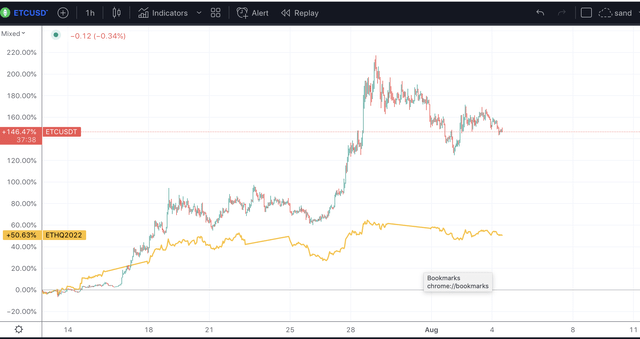gremlin/E+ via Getty Images
Thesis Summary
Ethereum (ETH-USD) is the world’s second-largest cryptocurrency by market cap, and since its inception in 2013, it has had a colourful journey to the top. Ethereum has been the victim of hacks, forks and now a controversial update, the “merge”, which could shake things up in the Ethereum ecosystem and even lead to the creation of yet another form of Ethereum.
In this article, I talk about Ethereum’s past to understand its future better.
A Brief History of Ethereum
Ethereum was founded in 2013 by Vitalik Buterin with the help of other household crypto names such as Gavin Wood and Charles Hoskinson. Ethereum was built from the start with the idea of allowing anyone to create decentralized applications. The project began to develop under a swiss company, Ethereum Switzerland GmbH, but would later become a non-profit organization known as the Ethereum Foundation.
On 30 July 2015, the Ethereum platform was officially launched, and the genesis block was mined. Since then, Ethereum has undergone numerous protocol upgrades and changes to its structure, with one of the most significant being the hard fork that took place in 2014, which led to the creation of Ethereum Classic.
In 2016, The DAO, a set of smart contracts on the Ethereum platform, managed to raise $150 million on a crowd sale, a very large amount at that time. However, the DAO was hacked, and $50 million of its funds were stolen. In what could be considered a contentious move, the Ethereum foundation decided to hard fork Ethereum’s blockchain reverse the hack. In other words, Ethereum Developers created a version of the blockchain where those hacks had not happened, though everything else until that point was identical.
This meant there was still a blockchain version containing the original transactions. A blockchain and token still exist today and are known as Ethereum Classic (ETC-USD).
Fast-forward to today, and Ethereum is undergoing its most significant upgrade yet, the merge, which will transition the network from Proof-of-Work to Proof-of-Stake. However, like with the fork that led to ETC, the coming merge is not welcome by all, and another divide is on the cards.
The Divisive Merge
As Ethereum has become larger, it has had to face new challenges. Namely, it has had to address the issue of high transaction costs and clogging of the network. Also, like Bitcoin (BTC-USD), Ethereum has come under scrutiny for its “unnecessary” energy consumption. These are the main reasons why Ethereum has decided to move from PoW to PoS.
With PoS, Ethereum will do away with mining, which requires vast amounts of computational power, which is, in turn, expensive and consumes energy. Instead, ETH will now be created and validated through staking, which means locking up a certain amount of ETH in order to validate transactions.
PoS has many advantages, and it has been hailed by many as the ultimate fix for Ethereum. However, there is a particular set of people who are understandably not as thrilled about this as others; miners.
Miners, which have so far been the backbone of the Ethereum ecosystem, will be left in the dust once the network switches to PoS. Yes, they can still stake their ETH, but the reward won’t be nearly as high, and they will be left with specialized and expensive equipment that won’t be useful anymore. To protect their interest, some miners are proposing doing what Ethereum did back in 2016. Create a fork and a new cryptocurrency.
One of the main proponents of this idea is Chandler Guo, who was also one of the leading forces behind the original ETH/ETC fork. Guo proposes forking the blockchain when the merge happens, meaning there would be two ETH chains. One PoW and one PoS. The proposed name for the forked blockchain is ETHPoW.
Closing Remarks: ETC vs ETH vs ETHPoW
So what do we make of all of this? How do ETC, ETH and ETHPoW compare, and which is the superior blockchain and/or investment?
Let’s begin by talking about Ethereum Classic. First off, it’s essential to understand why ETC started. When ETH forked to recover the funds stolen, many people thought this went against the principles of cryptocurrencies. A blockchain is supposed to be immutable, and the defenders of ETC adhere to the idea that “code is law”.
While I agree that the ETH fork was a wrong and perhaps even unnecessary move, another tenant of cryptocurrency is allowing a natural and decentralized democracy to take place. And while the idea of forking ETH may not have been completely democratic, since the Ethereum Foundation had and has a lot of control over the blockchain, the subsequent decision of developers to favour ETH over ETC was democratic. The people voted with their feet, and the proof is in the pudding. ETH is second only to Bitcoin and possesses over a $190 billion market cap. Meanwhile, ETC has a market cap of under $5 billion.
Having said this, it’s worth mentioning that ETC has been rallying strongly in the past month, even outperforming ETH.
There are two main reasons behind this rally. Some point out that as ETH approached the merge, miners are beginning to move to ETC, promoting increased activity and demand for the token. Another catalyst for this rally was the recent headline that AntPool was investing $10 million in ETH classic.
In my opinion, though, while ETC may be an interesting trading vehicle, its long-term fundamental prospects are quite poor.
Now, moving on to the possibility of ETHPoW, this is an intriguing prospect in my opinion. While the ETC/ETH fork was brought about by principle, ETHPoW would be born out of practicality and could actually represent a significant challenge to Ethereum.
While PoS is seen by many as superior to PoW, there is no definitive answer. PoS is more efficient but has issues such as increased centralization. There are actual practical reasons for going with ETHPoW and a very big incentive for ETH miners to push this.
At the very least, ETHPoW could act as the perfect backup in case problems occur with the merge.
Ultimately, I still believe Ethereum will succeed with the merge and remain a dominant force in the cryptocurrency space. Still, I am intrigued to see how the world will react to ETHPoW if it does actually happen.




Be the first to comment